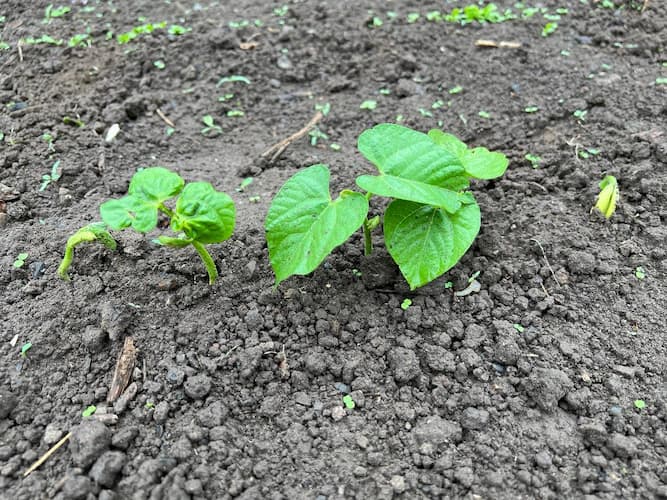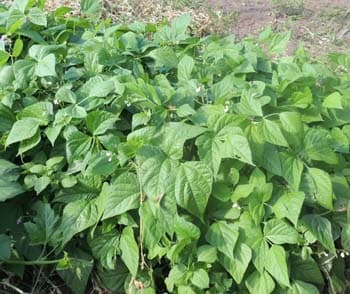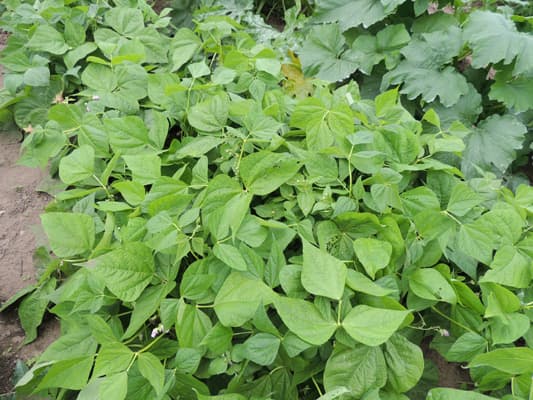How to Grow Beans

How to Grow Beans from Seed to Harvest
Growing beans are tops on your list. But, do you know what variety of garden bean you want to grow? Or, perhaps you will grow several varieties. Then, you’re in luck. ‘There is a wide variety of beans to choose from. You could say there is a bean for everyone. Each type of bean has a different distinct flavor and is used in different ways. Regardless of how many varieties of beans you decide to grow, our “How to Grow Beans” guide will help you to grow a stellar crop!
A bush bean or a pole bean? That is the question. Many varieties of beans can be found as either a pole or a bush bean.
Bush beans grow as small bushy plants close to the ground. They do not need support.
Pole beans are vining plants. The plant needs the support of a pole, trellis or fence, to grow and thrive. Also, it requires a longer time to reach maturity. Once the plants begin to produce, they do so for a longer period of time. A great advantage of pole beans is the bean grows straighter. And, they are easier to pick. Pole beans do not touch the ground. As a result, they are cleaner, bothered by fewer pests, and less likely to rot.
Did you Know? Astronauts are not allowed to eat beans before they go into space because passing wind in a spacesuit damages them. Not to mention another drawback in such a confined space…
The very best Snap Bean – Everyone has their favorite bean. The most popular varieties are Blue Lake Bush and Blue Lake Pole. Also, look for stringless varieties.
How to Grow Beans - Plant Varieties

Also, see specific bean varieties
Green Snap Beans- There are bush and pole green beans. Among the pole beans, you can find an Italian or Roma bean that is long, flat and has a stronger flavor. Green beans mature in 60-75 days, depending upon the variety. Pole varieties take a longer period to mature. Harvest when the bean reaches full size, but before the pod gets too fat. An overripe pod is tough. The bean loses its sweetness and becomes bitter.
Yellow Beans- Yellow beans only come in a bush variety. Many people will agree, it is the far better tasting of the two. And, more tender too.
Lima Beans, sometimes called Butter beans, come in the bush or pole varieties. The bean is flat and rounded, with a distinct flavor. Baby Lima beans are the sweeter of the varieties.
Shell Beans- There are a wide variety of shell beans, the most common of which is the Navy bean used to make baked beans. Shell beans are grown for the seed or bean inside the pod or shell.
Pinto Beans – A dried bean, popular in Mexican cuisine.
Fava Beans- A big, fat bean grown for its seed. Fava beans are great in soups.
Blackeye Peas – Is it a bean or a pea? You make the call. It’s also called “Cowpeas”. This favorite southern bean is grown for the bean inside. It grows in a slender pod that looks like a green bean. The bean inside is tan in color and has a black circle on it with a beige spot in the middle of the circle. Hence its name “Blackeye”.
Soybean– High in protein, fiber, and calcium. Its health and nutrition benefits make it increasingly popular in home gardens.
Scarlet Runner Bean – an edible ornamental bean…..KEWL!!!

Did You Know?
A bush variety can have some characteristics that revert back to a parental plant, and grow like a pole bean. There has not been much explanation of what may cause this, or if any environmental conditions enhance this occurrence. However, if your bush bean is producing runners like a pole bean, you can cut off the runners at a node just past the length they want the stem.
Did You Know? Mexican Jumping Beans jump to get out of the sunlight.
Days to Maturity
From 60 to 90 days to harvest, depending on the variety. In general, pole beans take about 10 – 15 days longer than bush beans.
If planted early, many areas can plant a fall crop. Importantly, fall crops may require more days to harvest, due to declining hours of sunlight and lower temperatures.
How to Grow Beans - Sowing Seeds
Grow bean plants in full sun. They require at least 6 hours of full sunlight. The soil should be rich and well-draining. The plants are heavy feeders. Add compost before planting. Apply a side dressing of fertilizer, to give these plants a fast start as soon as they germinate.
When growing beans, it is important to thin seedlings to the proper distance, as noted on the seed packet. If there are no directions, space plants three inches apart in rows three feet apart. Double rows are common in home gardens. When using double rows, leave enough room for them to grow without the rows overcrowding.
Pole beans and vining bean crops require some support. Fences, trellis, poles, or netting should be provided at sufficient height for maximum growth of the vines. Pest and Plant Netting work well as a support, too. Set up the netting like a fence. Also, you can also use netting to cover the crop to keep pests out.
For maximum growth and harvest, water frequently, especially during dry periods. Try to keep the leaves dry as you water. This will help avoid fungus diseases.
Apply a general-purpose fertilizer once a month during the season.
Keep beans well weeded all season long.
Also, See:
Soil Temperatures – Ideal germination temperature by vegetable
Ideal Soil pH – by vegetable
Harvesting Beans
As a rule of thumb, pick beans while pods are still tender. Pods can get stringy, especially as they mature.
For dried beans, pick after the pods have dried. The beans can be allowed to dry right on the vine.
How to Grow Beans - Insects and Pests
Most varieties of beans are susceptible to a variety of insects, most notably beetles. They can be effectively treated with Sevin, Diazinon, or a variety of other insecticides.
Bunnies love beans! Rabbits eat the tender new leaves and the beans, too. If there are rabbits in your area, a rabbit fence is not a nicety, it is a necessity. They will devastate a row of beans in a hurry, eating leaves, leaving just stems. As new leaves develop, they will come back for more.
More on control of rabbits in the garden.
Deer love to nip leaves of beans. If deer are a problem in your area, they will be a problem with your runner beans. Fencing or pest netting is the most effective control.
More on how to control deer in gardens.
How to Grow Beans - Plant Disease
Bacterial and wilt diseases are common among the Bean family. This plant disease arrives with summer heat and humidity. This often occurs just before, or during, the ripening of the crop. Fungicides are recommended in areas of high heat and humidity.
Bush varieties are generally more susceptible to plant disease than pole varieties.
Varieties have varying resistance to plant disease. If a plant disease is a persistent problem, look for disease-resistant varieties.
Tip: Keep the leaves dry and allow more spacing between plants for better air circulation.
Plant Problems – Diagnosis, causes, and cures for many common plant problems.
Plant Hardiness
Beans are not a hardy plant. They are susceptible to cold and frost. Hold off planting until a few days before all danger of frost is past. In the fall, cover the crop on nights when the temperature is expected to go below 40 degrees.
Bean Recipes
Recipes: May we suggest:
A Reason to Celebrate Beans
Bean Trivia – interesting bean facts and trivia
Eat Beans Day – beans get a special day of recognition
Please support our site. Shop for:
- rmmatthews100@hotmail.com
- 585-721-6528
- Rochester, NY
©1999-2024 GardenersNet.Com, All Rights Reserved

